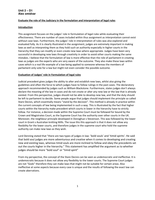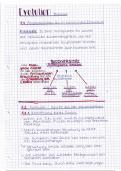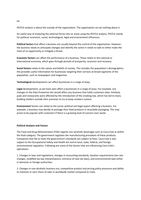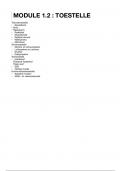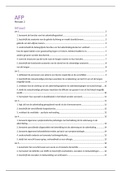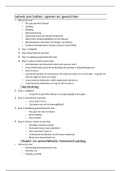EDITION
Complete Notes For
ECON 211 - Macroeconomics
[HOW TO THINK AND REASON
IN MACROECONOMICS]
DEFINITIONS, THEORY, GRAPHS AND CALCULATIONS SUMMARISED FOR CHAPTERS 1-4; 6-8 & 12.
SUMMARISED FOR EXAM PURPOSES WITH RELEVANT CLASS TESTS & PAST PAPERS AT THE BACK.
, How to think and reason in Macroeconomics 3RD
EDITION
Stuvia.co.za - GeekyS
DEFINITIONS
CHAPTER 1
Macroeconomics: The study of the structure and performance of the national economy and policies of government
that are used to Influence the performance of the economy.
Economic growth: Sustained increase in the trend level of (a) total production GDP or (b) per capita GDP (average
GDP per person)
Trend level = long term trend line around which short term cyclical fluctuations (business cycle) occur.
Indicates the long-term rate of increase in average material standard of living.
Development: the process that expands the range of choices that people have and improves their standard of living.
Inflation: Sustained increase in the general or average price level.
CHAPTER 2
Real consumption: Expenditure by households on consumable items and services.
Consumption function (C): Relationship between real consumption and real income.
Marginal Propensity to consume (MPC): the percentage of additional income that will be consumed
Marginal propensity to save (MPS): the percentage of additional income that will be saved
MPC + MPS = 1
Marginal propensity to import: Percentage of additional income that will be spent on imports.
Real Investment(I): The purchase of production / capital goods.
Multipliers: The Ratio between the eventual, cumulative change in Y and the original change in expenditure that
caused it. Any change in expenditure will result in a BIGGER change in income.
(Wikipedia: a factor of proportionality that measures how much an endogenous variable changes in response to a
change in some exogenous variable)
Total government expenditure = General government consumption (CG) + General government investment (IG).
Gross domestic Expenditure: The sum of Consumption (C), Business Investment (I) and Government expenditure
(G).
Total Expenditure: E = C+I+G+(X-M)
CHAPTER 3
Nominal interest rates: Interest rates at which banks charge the customer, like the prime rate or the rate earned on
a savings account.
Real interest rates: Interest rates earned in effect after the eroding effect of inflation has been removed from the
nominal value.
1
, How to think and reason in Macroeconomics 3RD
EDITION
Stuvia.co.za - GeekyS
Money: Medium of exchange / means of payment
E.g. cash (coins & notes) and money in cheque account. Can be used immediately to pay for transactions.
D
Demand for money (M ): The amount of money people require for transactions. Depends on the volume of goods
exchanged.
S
The money supply (M ): The nominal stock of money (money supply) is the amount of money that is present in the
economy at a particular moment The amount of money that the monetary system (Reserve Bank and financial
institutions) is supplying at a particular moment.
Repo rate (repurchase rate): The nominal rate that commercial banks have to pay when they borrow from the
Reserve Bank– function as ‘lender of last resort’.
Open market operations (OMO’s): The SARB’s buying and selling of government bonds in the secondary market
(issued for first time in primary market by Treasury).
‘Crowding out’: An increase in government expenditure will cause private investments to decrease Private
investment is “crowded out” by government expenditure.
IS curve: shows combinations of the real interest rate (r) and the real income (Y) that are consistent with equilibrium
in the real sector.
LM curve: shows combinations of the real interest rate (r) and the real income (Y) that are consistent with
equilibrium in the money market.
CHAPTER 4
The balance of payments (BoP): an accounting record of a country’s involvement in international trade and capital
flows. Balance of Payments = Current account + Financial account.
Exchange rate: denotes the international exchange value of the domestic currency against another currency.
Price ratio: the ratio between average price levels in the home country and those of the rest of the world.
PSA / Pforeign
Imports: Purchase of foreign products by domestic households, businesses and government.
M = ma + mY (chapter 2)
Exports: Purchase of domestic products by foreign households, businesses and government.
Current Account - Net income payments:
Wages received by SA citizens abroad / paid to foreign employees.
Dividends and interest earned abroad / paid to foreign investors.
Current Account - Net current transfers: Transfers (gifts /donations) made by SA citizens to foreigners and vice
versa.
Financial Account - Capital flows: Flows of foreign funds for the purpose of fixed investment as well as financial
investment.
Include foreign loans by private sector or government.
2
, How to think and reason in Macroeconomics 3RD
EDITION
Stuvia.co.za - GeekyS
Nominal exchange rate: Price of one currency in terms of another
An exchange rate exists between each pair of currencies in the world.
Depreciation: VALUE of the rand weakens
($1 = R9.00 to $1 = R10.00).
Appreciation: VALUE of the rand strengthens
($1 = R9.00 to $1 = R8.00)
Real exchange rate: An adjusted exchange rate that takes differences between countries’ price levels (inflation
rates) into account.
Real exchange rate = (1/nom exchange rate) x (PSA/Pfor)
The spot exchange rate: The conventional rate that’s determined daily for immediate (on the ‘spot’) trade in foreign
currency.
The forward exchange rate: The P & Q are agreed upon today for a transaction in the future.
BP curve: shows all combinations for Y & r that are consistent with conditions for BOP equilibrium.
CHAPTER 6
Aggregate Demand (AD): Illustrate all combinations of real income (Y) and the average price level (P) at which there
would be simultaneous equilibrium in the real and monetary sectors.
Aggregate Supply curve (AS): for each price level (P), the aggregate level of real output (Y) that producers are willing
or able to supply.
CHAPTER 7
Inflation: Sustained increase in the average price level.
CHAPTER 8
Balanced growth in Y (not Y/N): A growing-economy situation in which the ratios K/N and Y/N remain constant.
A steady-state: is a situation in which the economy’s output per worker, and capital per worker are constant
Human Capital: skills of individuals that allow them to be more productive
CHAPTER 12
Economic growth: Sustained, recurring annual increases in real GDP per capita (Y/N).
Unemployment: Someone who wishes to work and took specific steps to find a job but cannot find employment.
Inflation: Sustained increase in the average price level (see also chapter 7).
3
, How to think and reason in Macroeconomics 3RD
EDITION
Stuvia.co.za - GeekyS
THEORY & GRAPHS
CHAPTER 1
Economy = millions of individuals, workers, families, businesses, labour unions + millions of transactions and
activities
Macroeconomics = to summarise the impact of all the millions of actions. Understanding the behaviour of the
economy as a whole because this influences individuals and families.
Macroeconomic phenomena:
Business cycle
Unemployment
Inflation
Economic growth
Macroeconomic policy:
Government trying to improve the lives of citizens by combating NEGATIVES (high inflation, high
unemployment and poverty)
and enhancing POSITIVES like economic growth and development
BUT sometimes a trade-off between + and –
Why study macroeconomics?
Understand news & economists
Understand public debates on policy
Understand the impact of changes in interest rates, inflation rate, exchange rate, gold price, oil price, other
countries’ economic growth, etc.
Better informed citizens = better voters = better policy decisions = better standard of living…
Main objectives of macroeconomic policy:
1. Economic growth and low unemployment
2. Stability of output and employment levels
3. Stable and low inflation
4. Balance of payments equilibrium
5. Distribution of income and equity
6. Economic development and poverty reduction
GOAL 1: Economic growth and increasing employment
Generally believed that high economic growth will lead to an improvement in living standards of the entire
population (not necessarily true… later in chapter)
4
, How to think and reason in Macroeconomics 3RD
EDITION
Stuvia.co.za - GeekyS
How to measure economic growth:
Annual growth rate of real GDP
Economic growth rate2010 = (real GDP2010 – real GDP2009)/real GDP2009 x 100
Per capita GDP growth rate
Per capita growth rate2010 = (per capita GDP2010 – per capita GDP2009)/per capita GDP2009) x 100
Abovementioned method does not include cyclical component of GDP. To see the long term trend in
economic growth – take averages over longer periods
Does economic growth improve living standards?
Per capita GDP = real GDP / population
If the real GDP growth rate > population growth rate = increase in per capita GDP = increase in average
living standards
BUT even if per capita growth rate increases, ALL of the population is NOT necessarily better off.
It depends on how the economic growth is distributed amongst the population. Measured by the Gini
coefficient (see GOAL 5 – distribution of income).
SA: 10% richest population receives 51% of the total income, poorest 50% receive less than 10% of the
income.
Does economic growth reduce unemployment?
Not necessarily
If economic growth is due to the use of more capital intensive methods of production, unemployment will
not be reduced = jobless growth
We assume in the rest of the textbook that higher growth will result in lower unemployment. (Because it is
true most of the time)
How sustainable is economic growth? / What are the costs of economic growth?
Costs of economic growth
Pollution of the environment (air, water,…)
Waste material
Noise pollution
Climate change
Traffic
Congestion
Noise
Job stress
Depletion of national resources (SA = water, energy resources)
Growth with these costs does not necessarily bring a higher quality of life.
Goal 1 - Summary:
Economic growth is important to increase living standards and reduce unemployment
BUT
It depends on how the economic growth is distributed amongst the population (see goal 5)
If economic growth is due to the use of more capital intensive methods of production, unemployment will
not be reduced
Growth-at-all-costs approach will not be sustainable and will not bring higher quality of life.
5
, How to think and reason in Macroeconomics 3RD
EDITION
Stuvia.co.za - GeekyS
GOAL 2: Output and employment stability
Business cycle = economic upswings and downturns
In theory:
Upswings (increase in GDP) = more employment (less unemployment)
Downswings (slower growth / decrease in GDP) = less employment (more unemployment)
GOAL 2 = stability: less fluctuations in GDP = less fluctuations in employment
BUT if growth is capital intensive, increase in GDP does not automatically decrease unemployment
Then the unemployment problem is outside the reach of normal macroeconomic policy remedies.
Employment should be pursued as an objective in its own right – different kinds of unemployment requires
different kinds of policy.
Macroeconomic impacts on employment is still important, policy should just be broader than only
macroeconomics.
Measurement of inflation
Consumer price index (CPI)
Inflation rate 2010 = (CPI2010 – CPI 2009) / CPI 2009 x 100
GOAL 3: Stable and low inflation
NB to remember trade-off between inflation and other macroeconomic objectives:
Increase in economic growth (goal 1) = usually higher inflation
Decrease in unemployment (goal 2) = usually higher inflation… (chapter 7 & 12)
IF domestic inflation > inflation of trading partners
Domestic prices increase more than that of trading partners
Exports decrease, import increase = current account of balance of payments under pressure (goal 4)
Impact of inflation on redistribution of income (goal 5)
Borrowers benefit from inflation… (home owners)
Pensioners are harmed by inflation …
Inflation harms taxpayers …
Low-income households harmed more by inflation than higher-income households.
GOAL 4: Balance of Payments (BoP)
BoP components:
BoP = current account balance + financial account balance
current account = X (foreign currency inflow) – Z (foreign currency outflow) + NFP
Financial account = Foreign Liabilities (foreign currency inflow) - Foreign Assets (foreign currency
outflow)
If current account is in deficit, it must be financed by the financial account surplus.
To attract more foreign reserves (investments from foreigners or loans), increase interest rates.
Higher interest rates will decrease domestic investment necessary for growth.
Discussed in detail in chapter 4…
Objective = in the very long run the BoP should be in equilibrium (short term deficits or surpluses not a
problem)
BoP NB because:
BoP determines foreign reserves
Foreign reserves used to pay for imports, repay foreign debt and support currency (see chapter 4)
BoP have important effects on money supply and exchange rate adjustments
BoP has an important influence on policy objectives (e.g. GDP, growth, employment and inflation)
6
, How to think and reason in Macroeconomics 3RD
EDITION
Stuvia.co.za - GeekyS
GOAL 5: Distribution of income and equity
Does each individual or household in society earn a sufficient, fair or equitable share of the national income
and wealth?
South Africa = unequal distribution of income
10% of the population receives half of all the income, while the other 90% receives the other half.
How to measure inequality of the distribution of income?
Gini-coefficient (value between 0 – 1)
If closer to 0 more equal distribution of income
If closer to 1 less equal (more unequal) distribution of income.
• First world countries around 0.4
• Third world countries around 0.6
• SA = 0.68 in 1991, around 0.7 in 2005/6 – one of the highest in the world
• More info www.statssa.gov.za
GOAL 6: Development objective
What is development?
Def: process that expands the range of choices that people have and improves their standard of living.
Human development:
Process of enlarging people’s choices
Lead a long and healthy life
To be educated
Enjoy a decent standard of living
Entails much more than an only an increase in economic growth and employment or a better distribution
of income It is the development of people, their potential, their abilities…
How does one measure development?
Income / purchasing power
Education (level of schooling, literacy)
Life expectancy
Nutrition levels
Health (infant mortality rates)
Housing (persons per room, running water, sanitation)
Best composite indicator of development = Human Development Index (HDI) of the UN. Include:
Life expectancy (nutrition, health, shelter,…)
Knowledge (literacy, education…)
Income (purchasing power adjusted real GDP per capita).
What has macroeconomic policy to do with development?
Good development, which addresses poverty successfully, should produce improved income distribution
and economic growth.
Unwise development policy can threaten macroeconomic objectives:
To achieve development, government increases government expenditure (G)
G should be financed via higher taxes / foreign debt
G crowds out private investment
G can cause inflation
7


